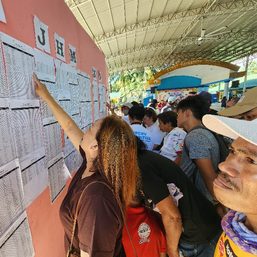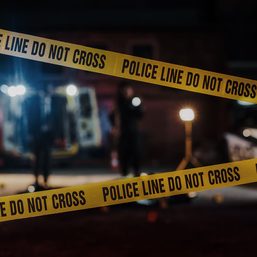SUMMARY
This is AI generated summarization, which may have errors. For context, always refer to the full article.

MANILA, Philippines – Filipinos head to the polls on Monday, October 30, to elect their leaders in their own villages for the first time in five years.
Voting centers in Muntinlupa – a pilot location for the early voting of vulnerable sectors – will accommodate senior citizens and persons with disabilities beginning 5 am, ahead of the 7 am regular opening of polls elsewhere in the country.
Filipinos can cast their ballots until polls close at 3 pm. Unlike the 2019 and 2022 national elections, the barangay polls are fully manual – from voting to canvassing – except in three villages.
Because the count is manual, a slower processing of results is expected, unlike in automated elections.

Long wait
The last time the Philippines elected officials in the barangay and Sangguniang Kabataan (SK) was in 2018.
The next round of village elections was slated in 2020, but in 2019, then-president Rodrigo Duterte moved the polls to December 2022.
In October 2022, President Ferdinand Marcos Jr. signed a measure resetting the date of the barangay polls to its current schedule. The postponement was later declared unconstitutional by the Supreme Court.
Advocates for clean polls have repeatedly decried the delays. They said the postponements deprived the electorate the opportunity to regularly elect their leaders.
Watchdogs also pointed out that the five-year gap between the 2018 and the 2023 elections took away the chance of some youths to run for Sangguniang Kabataan, because they are already past the age limit.
For the 2023 barangay and SK polls, a total of 672,432 seats will be contested by 1.41 million people who threw their hat in the ring.
Some 67.8 million people are eligible to cast their ballots for the barangay election, while 23.2 million people are registered in the SK poll.
The Commission on Elections (Comelec) said it is eyeing a voter turnout of at least 75%, to surpass the 69% turnout in 2018.

What’s different
This is the first nationwide election in which Comelec Chairman George Garcia – a veteran election lawyer – is in the driver’s seat.
Under his leadership, the poll body has introduced initiatives that were seen as attempts to crack down on persistent electoral ills.
These include the creation of a permanent committee against vote-buying, and a reinterpretation of a Supreme Court ruling that enabled the Comelec to go after premature campaigners.
Ahead of election day, the commission, on its own, filed disqualification petitions over 200 individuals for premature and illegal campaigning. Show-cause orders were also issued to more than 8,700 election aspirants.
The Comelec also ordered the suspension of proclamation of winning candidates with pending disqualification cases, which means they won’t be able to assume their posts until they have been cleared by the poll body.
Other new features of this latest round of the barangay polls include mall voting in select areas, and the use of vote-counting machines for three villages in Luzon.

Violence
Elections can be bloody, and this poll cycle is no exception, as the Comelec has logged around two dozen incidents of election-related violence since August, with eight reported deaths.
Over the weekend, local authorities reported separate arson incidents in two schools that will be used as voting centers in Maguindanao del Norte.
So far, only two places have been placed under Comelec control – the entire province of Negros Oriental, where the governor was assassinated in March, and Libon, Albay, which has witnessed a series of killings attributed to tense grassroots-level politics.
Overall, more than 200 villages in the Philippines fall under the red category, or areas of grave concern. – Rappler.com
Add a comment
How does this make you feel?
![[OPINION] Tough times call for ‘flexible’ governance](https://www.rappler.com/tachyon/2023/11/Tough-times-call-for-flexible-governance.jpg?resize=257%2C257&crop=264px%2C0px%2C720px%2C720px)
![[OPINION] Political terrain in Taguig has shifted](https://www.rappler.com/tachyon/2023/11/binay-cayetano-taguig-november-22-2023.jpg?resize=257%2C257&crop_strategy=attention)



There are no comments yet. Add your comment to start the conversation.